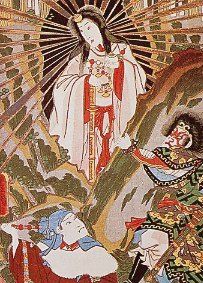What speaks most eloquently of a universal matriarchal past is the abundance of female figurines in stone, clay, plaster and metal found in what’s believed to be sacred settings everywhere--from southern Africa to Siberia and across the globe from China and Japan to India, Ireland and the Americas. These archeological finds, generally assumed to represent a Goddess, or goddesses, are humankind’s first known objects of worship and among the earliest and most common of all artistic motifs. Nearly all human images dating from 30,000--5000 BCE are of women, and everywhere in the world’s religious traditions the presence of goddesses is overwhelming.
Statuettes with greatly emphasized sexual parts (dating from c 30,000 BCE), discovered in the caves of northern Spain and southern France but also, e.g., in China (the Hongshan culture), are believed to have been objects of a religion that considered the female body divine. The women portrayed, who are always naked (sometimes with outspread legs, slender and sexually alluring, sometimes ample and nursing a child), seem to indicate that our prehistoric ancestors conceived of the divine as a maternal power that nurtured and provided for them.
The Mother Goddess
The figurines are all believed to portray the same mother goddess, Great Goddess, Magna Mater and Mother Earth, who later became prevalent in agricultural societies; there is for instance a great similarity in style between the early Old Stone Age (paleolithic) figurines and the later New Stone Age (neolithic) ones, from 9500 BC onwards. A glossary of pictorial motifs compiled from about two thousand artifacts belonging to both these periods shows how the Goddess’s power is everywhere: in water and stone, in tomb and cave, in animals, birds, snakes and fish, in hills, trees and flowers. A trait common to many depictions of the goddess is that she lacks feet, as if coming straight out of the earth with which she’s identified
Analytical psychologist and Jungian scholar Erich Neumann points out that the sexual symbolism in primeval cult and ritual (as always in mythology) isn’t concerned with any personal, genital aspects but represents the creative element in life and has a sacral and transpersonal meaning. The goddess, regarded as self-generating (parthenogenetic) and as the single source of all life, is a virgin, (Greek, parthenos) which everywhere in the ancient world means a woman who belongs to no man in particular but simply stands, like the man, in the service of fertility. Virginity in this sense is sacred because seen as a state of psychic openness to the divine.
The remarkable similarity between all those objects suggests a consensus about the almost sacred status of the feminine. According to Joseph Campbell (a scholar who made a survey of the spiritual history of mankind with his comparative studies of world mythology), woman was once prodigiously
powerful, because the center and origin of an effective magic. The natural mysteries of the menstrual cycle, childbirth, and the flow of mother’s milk--in themselves manifestations of power--were primary sources of religious awe.
Was prehistoric society female-managed?
Writes David Kinsley in The Goddesses’ Mirror, “Since women embodied the Goddess's life-giving power and the role of males in the reproductive process may not yet have been known, much speak for the theory that this goddess-centered society was also female-managed.”
The Mother Goddess
 |
| Nile Goddess |
Analytical psychologist and Jungian scholar Erich Neumann points out that the sexual symbolism in primeval cult and ritual (as always in mythology) isn’t concerned with any personal, genital aspects but represents the creative element in life and has a sacral and transpersonal meaning. The goddess, regarded as self-generating (parthenogenetic) and as the single source of all life, is a virgin, (Greek, parthenos) which everywhere in the ancient world means a woman who belongs to no man in particular but simply stands, like the man, in the service of fertility. Virginity in this sense is sacred because seen as a state of psychic openness to the divine.
 |
| Fertility Goddess, Ecuador |
powerful, because the center and origin of an effective magic. The natural mysteries of the menstrual cycle, childbirth, and the flow of mother’s milk--in themselves manifestations of power--were primary sources of religious awe.
Was prehistoric society female-managed?
Writes David Kinsley in The Goddesses’ Mirror, “Since women embodied the Goddess's life-giving power and the role of males in the reproductive process may not yet have been known, much speak for the theory that this goddess-centered society was also female-managed.”
In myths from far and wide the Great Goddess also appears as the Terrible Female, monster, witch, vampire, ghoul, specter, whose womb is deadly and devouring. Then she’s symbolized by things like the underworld, hell, darkness, nothingness, by a toothed vagina or by a mouth with a boar’s tusks, fangs, an outstretched tongue.
It is therefore clear and beyond doubt that in the era predating recorded history goddess worship was practiced all over the world. In Japan a long surviving memory of it is the divine status of the emperor (renounced only after WWII) which was based on the first emperor’s marriage to the sun goddess Amaterasu.
 |
| Amaterasu, Japanese Sun Goddess |
Check The Myth of the Myth of Matriarchy
I welcome feedback and would love for you to leave a comment. You can post a comment below this article or you can click on this article's headline.
For the full blog click originofsexism.blogspot.com
For the full blog click originofsexism.blogspot.com


No comments:
Post a Comment
I welcome feedback, please leave a comment!